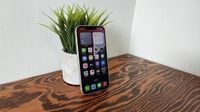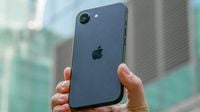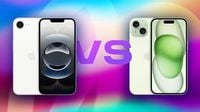Apple's latest iPhone 16e has quickly become one of the company’s most controversial products. After axing the SE from their lineup and bumping up the price of their “lowest” priced phone, the iPhone 16e has not initially received much love from many tech enthusiasts. However, I have had a different perspective on it, finding it to be a near-perfect device, albeit with some compromises that could turn some users off.
Like typical modern Apple iPhone unboxings, you won’t find much more than the iPhone itself and a charging cable (and SIM removal tool for markets with a SIM card tray). However, I was rather surprised to see that Apple’s cable was actually braided this year, compared to their old-style cables that were known to kink, bend, and discolour over time. Sadly, gone seem to be the days of getting Apple stickers in the box, and I still wish Apple included them. You still won’t find a charging block in the box either, although I’m sure this is something we’ve all come to “expect” from Apple and other industry-leading smartphone manufacturers.
Looking at the iPhone 16e itself, the first thing many people will immediately notice is the matte glass and single camera on the back of the device. While we will dig into the camera details later, I was extremely pleased to find matte glass here. I personally hate seeing loads of fingerprints all over my devices, and this greatly solved that problem. I feel it makes the iPhone 16e look stunning. I would have liked to have seen more color options than just black or white, though. This can easily be dealt with by buying a skin from a third party. Plus, with most people covering up their phones with cases, I don’t imagine as many people will be bothered by this other than when first seeing their device.
The next noticeable “feature” of the iPhone 16e users will notice is the notch making its return to the screen. While I never had a problem with this, as my last iPhone was an iPhone 13 Mini, those coming from phones without a notch or other iPhones with “Dynamic Island” may see this as a bit of a drawback, although we will also dig into more details about this screen later in the review. I was pleased to see Apple has included their action button instead of the old rocker switch along the left side of the phone, as it offers additional versatility and customization for the user and lets me set it to do what I find most useful. Additionally, thanks to the EU, USB Type-C is the connection you will find along the bottom of the phone. This was something I was extremely thrilled to see, as I can now carry one cable to charge all of my devices instead of having to carry an additional Lightning cable just to charge my phone.
As mentioned earlier, Apple has removed the iPhone SE from its current lineup of phones, which, while a little sad, I found the SE was due for a much-needed refresh from its current state. The screens were underwhelming, and the camera and battery left a lot to be desired, especially for a phone in 2025. While the price may have been appealing to those back then, I never found myself able to recommend it to anyone. With the iPhone 16e now being their “low-cost” device, let’s start digging into what Apple has done to make the 16e, in my mind, “the iPhone for the average user.”
Starting with the display itself, Apple has only given one option, similar to that of the SE, in a 6.1-inch size. I found this to be an appropriate size as it’s not so large you can’t stick it in your pocket, but it’s also not so small that you find yourself wanting something bigger. I have smaller hands and have always loved Apple’s “Mini” phones for the extra portability, but lately, I have found myself wanting just a little extra-screen real estate. This 6.1-inch display is about perfect for what I would want to use on a daily basis. The screen is still sharp with a 2532×1170-pixel Super Retina XDR display, similar to those found on the slightly older iPhone 14 lineup. “The 6.1-inch display is about perfect for what I would want to use on a daily basis.”
While there are sure to be those who will complain about the notch on the screen, it is important to remember this is a significant upgrade over the SE lineup, which was still using a similar screen to that of the much older iPhone 8! Yes, having a screen with Dynamic Island like more expensive phones would be great, but this is still the lowest-end offering from Apple, so cost cuts had to be made somewhere. I find it to still be more than adequate for my day-to-day usage.
I had no issues using the iPhone 16e’s screen, even after coming from my previous Motorola ThinkPhone with a larger 6.6-inch screen. The iPhone 16e held its ground and felt large enough for me to go about my day and get things done. Outdoors, where I often am while working, I found the screen was plenty bright enough to use, even under bright lighting—something I wasn’t always able to say for my Motorola. One noticeable difference was the screen refresh rate, which only comes in at 60Hz. While this wasn’t something I necessarily found to be a compromise since even the iPhone 16 doesn’t offer a higher refresh rate, it would be nice to see Apple one day offering this, as lower-cost phones have even started shipping with faster screens. Those coming from phones that haven’t offered a fast refresh rate are unlikely to notice the difference, though, so I was able to live with it in most cases.
A pleasant surprise I found coming from older iPhones to the new iPhone 16e was the much longer battery life. While I wouldn’t call myself a power user, during a typical workday as a trucker, I use my phone to perform a wide range of tasks, from navigation to clearing work calls and checking emails, as well as my usual slew of games and apps when taking a break. Even with all that, I could normally get a full day (6:30 a.m.–8 p.m.) before having to consider charging it up for the night. Even still, I could usually get closer to bedtime before being critically low.
On my lighter-use days, mainly on weekends, I could get through a full day of use and even manage to use the phone for a few hours the following day before needing to charge it. Most previous phones I have used were lucky to last until the next day, and they all generally had significantly larger batteries. Topping up when it’s time to charge is as simple as using a wireless charger or USB-C cable. I was beyond thankful for USB-C, as it now allows me to use an iPhone as a daily device without having to worry about needing a Lightning cable for just my phone, while all my other devices use USB-C. Now things are as simple as carrying a single cable and charging block or power bank for all my devices. Gone, however, is MagSafe, something all other iPhones in Apple’s current phone lineup support. While I did not find this to be a huge loss, as Apple had to cut costs somehow to make the iPhone 16e cheaper than the 16, those wishing to still use MagSafe can opt for cases that incorporate it. My current favourite is the Enzo Aramid by Spigen. Surprisingly, Apple hasn’t even built MagSafe into their own cases—more on this later. Those who haven’t previously used MagSafe likely won’t be disappointed by its absence here.
New to the iPhone lineup is Apple’s new C1 modem, replacing the old Qualcomm modems in all previous iPhones. While it may not support Wi-Fi 7 like its more advanced siblings, this is not as fast as other offerings but Apple sticking the modem in their “entry” level device is a great way to test it in the real world without risking upsetting those who paid a premium for their highest-end iPhone. While I didn’t personally notice any real difference in cellular reception (for better or worse), I did find the overall performance was able to keep up with my daily workflow, and I never found it lacking in any noticeably bad ways. If Apple can further tune and improve these modems in time, they could eventually start out performing all other devices on the market.
Another aspect where Apple has cut costs is by removing a GPU core from the A18 processor found in the iPhone 16e. This is one core fewer than in the iPhone 16; however, I did not find this made too much of a difference in my personal experience using the phone. Games still played fluently and seamlessly, including more demanding titles such as Genshin Impact. While most of my workload isn’t as GPU-dependent and is more CPU-demanding, with multiple apps regularly working together all at once, thankfully Apple has still kept all six cores on the A18. I never found any times when my apps would crash, and multitasking always worked very well. This is additionally helped by the 8GB of RAM, 2GB more than last year’s iPhone 15 or double that of the iPhone 13 Mini I was previously used to.
After not using an iPhone for a handful of months, iOS 18.3.2 took a couple of minutes to adapt to, mainly locating everything in settings and learning the new drop-down Control Panel. However, this was not anything too overwhelming to get used to. iOS has always been an operating system I have found simple to use, which, as a tech nerd, is both nice and irritating at the same time. “Games still played fluently and seamlessly, including more demanding titles such as Genshin Impact.” Apple has thankfully greatly improved their customization options over the years; however, you won’t find anything “revolutionary,” as Apple likes to call their improvements. One aspect I am especially thankful for is Apple’s long support for their devices, something Android is finally catching up on now. Even at its cheaper cost, I am confident Apple will likely continue to support the iPhone 16e for years to come.
One thing many often comment on when they see me using the iPhone 16e is, “What phone are you using?” or “Where are all the cameras?” To be honest, that’s a fair comment. When even many significantly cheaper phones on the market have at least two rear-facing cameras, it is a fair assessment to make. Only seeing a single rear camera does have a slight “retro” feel to it, as if I’m back to using my old iPhone 5S.
But how is that camera? In my testing, I found it to be adequate for most situations but lacking in some aspects. Apple is calling the iPhone 16e’s camera a 2-in-1 camera system, combining both a 1x and 2x telephoto lens into one through the use of a 48MP 26mm ƒ/1.6 aperture lens. The lens, as one would hope, is equipped with optical image stabilization and has a wide range of options to tune your photos to your liking. When using the camera on the iPhone 16e, I was almost always able to capture a photo that I liked, even in some pretty low-light settings, such as a dark room or out at night. Photos came out clear and crisp, especially when lighting was plentiful.
What often surprised me was seeing just how much light this single lens could pull from a darker-lit room. Sure, this isn’t any Pro Max-level iPhone with a LiDAR sensor, but in most cases, I could still capture a photo that had an adequate level of detail and sharpness. What you miss from almost every recent iPhone is an ultrawide lens, something I didn’t realize how much I used until I suddenly didn’t have the option available. While in some situations, stepping a couple of steps back may help mitigate this, it isn’t something that can always be done, and I would’ve gladly traded the zoom lens for an ultrawide.
For all that I find Apple gets right with the iPhone 16e, there has been a lot of commotion over the choices they’ve made. Many people are saying that for what you’re paying, you should have a faster refresh rate, MagSafe, better cameras, etc., all for a better price. On one hand, I will say I do, to a degree, wish Apple had made some different choices. However, in my time using the iPhone 16e, it was a very competent phone for me, and as someone who doesn’t really care about some of the “extras” that Apple axed from it, I feel the iPhone 16e is a near-perfect phone for my daily life.
For the person who is upgrading from an older iPhone 8 or a similar phone, this will feel like a massive upgrade compared to what they are used to. Battery life will be significantly better, the screen will be much easier to view, and performance will be vastly better than what they are coming from. The cameras will also take much better photos than older devices. Going up to $599 from $429 is a big leap, but if Apple were able to make the price closer to the $500 mark, I could see the iPhone 16e being a much better overall deal for what you’re getting.
In my last few weeks of using the iPhone 16e, it was overall a great device to use in my experience. While it does make compromises compared to other new or even previous iPhone lineups, you’re still getting Apple’s legendary device support and a phone that will outperform the majority of other Android-based devices on the market—all in a size and at a price significantly lower than much of the competition. If you’re looking for the best overall cameras or the best screen, this isn’t the phone for you. But if you’re looking for the most affordable modern iPhone and don’t really care about the extra bells and whistles, check one out in store if you can—you might find that the iPhone 16e is exactly what you’re looking for. In the end, this was a device I went out and bought for myself as my new daily driver.



